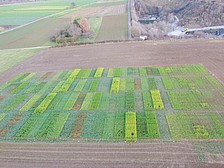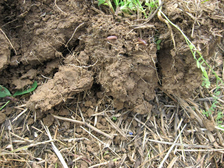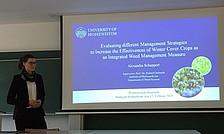Effects of tillage systems and cover crops on the water cycle and weed suppression in maize cropping systems
Alexandra Schappert (PhD Defence 2020)
Alexandra Schappert was defending her PhD Thesis in February 2020.
University of Hohenheim, Stuttgart
Institute of Phytomedicine (360), Weed Science (360b)
Supervisor: Prof. Roland Gerhards
Challenges
The agricultural cropping management has huge impact on the water balance. Different tillage systems influence soil water infiltration, water holding capacity and run off. Conservation tillage in combination with cover crops may influence water availability and weed suppression. Weeds in maize crop production are a serious challenge causing yield losses of up to 100 % (Rajcan and Swanton, 2001). Thus, pre- and post-emergent herbicides need to be applied with the risk of crop damage, soil water contamination. The objectives of this study are (i) to estimate the negative and positive impacts of conservation tillage systems and cover crops on water availability, and (ii) to possibly reduce herbicide usage to improve th sustainability of maize cropping systems.
Objectives
- To assess the importance of conservation tillage and cover crops on the water balance to promote water efficiency in maize cropping systems.
- Identify the weed suppression potential of cover crops and their suppression mechanism by quantifying the aboveground weed and cover crop vegetation biomass (composition).
- Verify the water supply and weed suppression benefits of different cover crops, and their mulch, at different locations and climate conditions.
Expected results
The data and information obtained through the proposed study will help to estimate the effects of tillage systems and cover crops on weed suppression. Additionally soil moistrue measurements and soil samples will help to determine effects of tillage systems and cover crops on the local water cycle. This will enable to create a cropping calendar; giving recommendations which cover crop mulched at a specific time may have the best effects on specific soil water characteristics and on weed suppression to avoid the use of herbicides. Additionally this information may help to recruit decision support system to advice farmers and extension planning.
This study will obtain information on the effects of cover crops on weed suppression, as effect of light and water shortage and inhibitory substances. The extend of herbicide input my be reduced by conservation tillage and cover crops and soil water quality may improve.
Aims
- Conservation tillage in combination with cover crops has advantages for the water balance and maize yields on a loamy soil in South Germany in comparison with a conventional maize monocropping system without cover crops.
- Well suited weed suppression mechanisms of cover crops can reduce weeds density in maize cropping systems below the damage threshold to promote a reduction of herbicides usage.
- Location specific water efficient cover crops have the best weed suppression potential in comparison to allelopathic active cover crops.
Methods
At the research station "Ihinger Hof", different cover crops and cover crop mixtures will be tested for their weed suppression potential. We will employ a completely randomized field trial (Workpackage: M1) with 4 replications. The cover crops will be established after harvest in autumn and will be (i) mulched, (ii) incorporated with a plough or maize will be sown by direct drilling (iii) in spring. During the growing period of the cover crops and the maize crop, destructive measurements, as well as light intensity measurements and soil moisture measurements (PR2 sensor), will be part of the data collection. That will help to identify the effect of cover crops on the water balance on weed germination and biomass allocation by competition.
Field research/ green house experiments: effects of tillage systems and cover crops (residues) on the water balance and maize yield.
The main activity is the data collection during the entire growing season of the cover crops and the maize crop. Plant development will be closely observed and emergence, [...] and maturity dates will be recorded according to each treatment. Therefore, destructive biomass measurements, as well as indirect methods (e.g. leaf area index (LAI) measurements) to develop effects on yield parameters will be conducted. We are working on the biomass estimation of maize and cover crops via remote sensing together with Robin Mink (M2). Soil moisture measurements and soil samples (density, nutrients) will help to determine effects of tillage systems and cover crops on the local water cycle. A micro-meteorological station will provide weather data. Influences on soil moisture will be monitored by frequency domain (FDR) sensors.
In addition, soil probes with different cover crops will be placed in the greenhouse (M3) and irrigated according to a specific schedule. That will help to determine their water use efficiency and the potential of different cover crops to puffer extreme weather conditions like droughts. Indirect as well as destructive methods will be used to verify their performance. The crop growth Modell EXPERT-N will help to justify and complete these observations (M4).
References
Rajcan, I. and Swanton, C. J. (2001) ‘Understanding maize–weed competition: resource competition, light quality and the whole plant’, Field Crops Research, vol. 71, no. 2, pp. 139–150.
Peer reviewed publications:
1. Schappert, A., Messelhäuser, M. H., Saile, M., Peteinatos, G. G., Gerhards, R, 2018. Weed Suppressive Ability of Cover Crop Mixtures Compared to Repeated Stubble Tillage and Glyphosate Treatments, Agriculture, 8 144.
2.Schappert, A., Schumacher, M., Gerhards, R., 2019. Weed Control Ability of Single Sown Cover Crops Compared to Species Mixtures. Agronomy, 9,294
3.Schappert, A., Linn, A.I., Sturm, D.I., Gerhards, R., 2019. Weed suppressive ability of cover crops under water-limited conditions. Plant, Soil and Environment, 65, 541-548
4.Schumacher, M., Schappert, A., Gerhards, R., 2020. Effects of cover crop in pure stands and in mixtures on weed control and performance of maize (Zea mays). Julius-Kühn-Archiv, 464, 432-437







